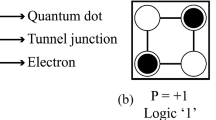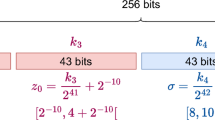Abstract
Nowadays, security and confidentiality are considered as important aspects throughout the growth of computerized systems, information technology, and internet communication. The cryptographic algorithms are used to improve the security against various threats/attacks (e.g., differential attacks and statistical attacks). In this research, the modified PRESENT architecture is proposed to improve the security against unauthorized users while minimizing the hardware utilization. The PRESENT architecture is modified by proposing three key strategies; (1) three Stage Reversible Logic Key Generation (3S-RLKG) is developed to generate the optimal key value using three different gates such as Feynman gate, DFG gate and Toffoli gate, (2) Modified Key Scheduling (MKS) and Bit Reversible Function (BRF) is additionally used in the PRESENT architecture to increase the confusion property and (3) mitigation of the Read-Only Memory (ROM) to store the intermediate values in the Field Programmable Gate Array (FPGA) processor. Therefore, the higher confusion property leads to an increase in the security against the unauthorized users. The performance of 3S-RLKG-PRESENT architecture is evaluated by means of the number of slice registers, flip flops, number of Look Up Table (LUT), number of logical elements, slices and bonded input/output block (IOB). Moreover, the 3S-RLKG-PRESENT architecture is also analyzed in the Spartan 6 XC6SLX9 -2 TQG144 FPGA hardware. The 3S-RLKG-PRESENT architecture is compared with different existing PRESENT architectures namely Maximum Distance Separable (MDS) based PRESENT, PRESENT, PRESENT with X Compactor, PRESENT- Round Key Generation (RKG), PRESENT- Storage Mode (SM) and Pseudo Random Bit Generator (PRBG). The 3S-RLKG-PRESENT designed in the Spartan 6 consumes 131 LUTs, 70 flip flops and 48 slices which are less when compared to the PRESENT-RKG.


























Similar content being viewed by others
References
Mohd, B. J., Hayajneh, T., Khalaf, Z. A., & Ahmad Yousef, K. M. (2016). Modeling and optimization of the lightweight HIGHT block cipher design with FPGA implementation. Security and Communication Networks, 9(13), 2200–2216. https://doi.org/10.1002/sec.1479
FaghihiSereshgi, M. H., Dakhilalian, M., & Shakiba, M. (2016). Biclique cryptanalysis of MIBS-80 and PRESENT-80 block ciphers. Security and Communication Networks, 9(1), 27–33. https://doi.org/10.1002/sec.1375
Tappari, S., & Sridevi, K. (2018). Review on lightweight hardware architectures for the crypt-analytics in FPGA. International Journal of Engineering & Technology, 7, 1888. https://doi.org/10.14419/ijet.v7i3.14138
Tappari, S., & Sridevi, K. (2019). Resource optimized security coding in light weight security protocol. International Journal of Innovative Technology and Exploring Engineering (IJITEE), 8(10), 2278–3075. https://doi.org/10.35940/ijitee.j9393.0881019
Kitsos, P., Sklavos, N., Provelengios, G., & Skodras, A. N. (2013). FPGA-based performance analysis of stream ciphers ZUC, Snow3g, Grain V1, Mickey V2, Trivium and E0. Microprocessors and Microsystems, 37(2), 235–245. https://doi.org/10.1016/j.micpro.2012.09.007
Abed, S. E., Jaffal, R., Mohd, B. J., & Alshayeji, M. (2019). FPGA modeling and optimization of a Simon lightweight block cipher. Sensors, 19(4), 913. https://doi.org/10.3390/s19040913
Biswas, A., Majumdar, A., Nath, S., Dutta, A., & Baishnab, K. L. (2020). LRBC: A lightweight block cipher design for resource constrained IoT devices. Journal of Ambient Intelligence and Humanized Computing. https://doi.org/10.1007/s12652-020-01694-9
Lu, J., & Seo, H. (2020). A key selected s-box mechanism and its investigation in modern block cipher design. Security and Communication Networks. https://doi.org/10.1155/2020/1457419
Zhang, F., Guo, S., Zhao, X., Wang, T., Yang, J., Standaert, F. X., & Gu, D. (2016). A framework for the analysis and evaluation of algebraic fault attacks on lightweight block ciphers. IEEE Transactions on Information Forensics and Security, 11(5), 1039–1054. https://doi.org/10.1109/TIFS.2016.2516905
Dey, P., Rohit, R. S., & Adhikari, A. (2018). Single key MITM attack and biclique cryptanalysis of full round Khudra. Journal of Information Security and Applications, 41, 117–123. https://doi.org/10.1016/j.jisa.2018.06.005
Emami, S., Ling, S., Nikolić, I., Pieprzyk, J., & Wang, H. (2014). The resistance of PRESENT-80 against related-key differential attacks. Cryptography and Communications, 6(3), 171–187. https://doi.org/10.1007/s12095-013-0096-8
Han, G., & Zhang, W. (2017). Improved biclique cryptanalysis of the lightweight block cipher piccolo. Security and Communication Networks. https://doi.org/10.1155/2017/7589306
Cao, M., & Zhang, W. (2019). Related-key differential cryptanalysis of the reduced-round block cipher GIFT. IEEE Access, 7, 175769–175778. https://doi.org/10.1109/ACCESS.2019.2957581
Li, P., Zhou, S., Ren, B., Tang, S., Li, T., Xu, C., & Chen, J. (2019). Efficient implementation of lightweight block ciphers on volta and pascal architecture. Journal of Information Security and Applications, 47, 235–245. https://doi.org/10.1016/j.jisa.2019.04.006
Bansod, G., Raval, N., & Pisharoty, N. (2014). Implementation of a new lightweight encryption design for embedded security. IEEE Transactions on Information Forensics and Security, 10(1), 142–151. https://doi.org/10.1109/TIFS.2014.2365734
Kumar, M., Suresh, T. S., Pal, S. K., & Panigrahi, A. (2020). Optimal differential trails in lightweight block ciphers ANU and PICO. Cryptologia, 44(1), 68–78. https://doi.org/10.1080/01611194.2019.1650844
Tappari, S., & Sridevi, K. (2021). FPGA implementation of proficient lightweight architecture for present block cipher. International Journal of Future Generation Communication and Network, 14(1), 592–601.
Liu, G. Q., & Jin, C. H. (2015). Differential cryptanalysis of PRESENT-like cipher. Designs, Codes and Cryptography, 76(3), 385–408. https://doi.org/10.1007/s10623-014-9965-1
Xuan, L. I. U., Zhang, W. Y., Liu, X. Z., & Feng, L. I. U. (2014). Eight-sided fortress: A lightweight block cipher. The Journal of China Universities of Posts and Telecommunications, 21(1), 104–128. https://doi.org/10.1016/S1005-8885(14)60275-2
Patranabis, S., Roy, D. B., Chakraborty, A., Nagar, N., Singh, A., Mukhopadhyay, D., & Ghosh, S. (2019). Lightweight design-for-security strategies for combined countermeasures against side channel and fault analysis in IoT applications. Journal of Hardware and Systems Security, 3(2), 103–131. https://doi.org/10.1007/s41635-018-0049-y
Azari, H. D., & Joshi, P. V. (2018). An efficient implementation of present cipher model with 80 bit and 128-bit key over FPGA based hardware architecture. International Journal of Pure and Applied Mathematics, 119(14), 1825–1832. https://doi.org/10.1049/iet-cds.2018.5273
Haider, Z., Javeed, K., Song, M., & Wang, X. (2019). A low-cost self-test architecture integrated with present cipher core. IEEE Access, 7, 46045–46058. https://doi.org/10.1109/ACCESS.2019.2907717
Lara-Nino, C. A., Diaz-Perez, A., & Morales-Sandoval, M. (2017). Lightweight hardware architectures for the present cipher in FPGA. IEEE Transactions on Circuits and Systems I: Regular Papers, 64(9), 2544–2555. https://doi.org/10.1109/TCSI.2017.2686783
Rashidi, B. (2020). Flexible structures of lightweight block ciphers PRESENT, SIMON and LED. IET Circuits, Devices & Systems, 14(3), 369–380. https://doi.org/10.1049/iet-cds.2019.0363
Pandey, J. G., Goel, T., & Karmakar, A. (2019). Hardware architectures for PRESENT block cipher and their FPGA implementations. IET Circuits, Devices & Systems, 13(7), 958–969. https://doi.org/10.1049/iet-cds.2018.5273
Rashidi, B. (2019). High-throughput and lightweight hardware structures of HIGHT and PRESENT block ciphers. Microelectronics Journal, 90, 232–252. https://doi.org/10.1016/j.mejo.2019.06.012
DeCnudde, T., & Nikova, S. (2017). Securing the PRESENT block cipher against combined side-channel analysis and fault attacks. IEEE Transactions on Very Large Scale Integration (VLSI) Systems, 25(12), 3291–3301. https://doi.org/10.1109/TVLSI.2017.2713483
Ma, X., Mou, J., Liu, J., Ma, C., Yang, F., & Zhao, X. (2020). A novel simple chaotic circuit based on memristor–memcapacitor. Nonlinear Dynamics, 100(3), 2859–2876. https://doi.org/10.1007/s11071-020-05601-x
Yang, F., Mou, J., Ma, C., & Cao, Y. (2020). Dynamic analysis of an improper fractional-order laser chaotic system and its image encryption application. Optics and Lasers in Engineering, 129, 106031. https://doi.org/10.1016/j.optlaseng.2020.106031
Hasan, F. S., & Saffo, M. A. (2020). FPGA hardware co-simulation of image encryption using stream cipher based on chaotic maps. Sensing and Imaging, 21(1), 1–22. https://doi.org/10.1007/s11220-020-00301-7
Funding
This research has not received any research grant.
Author information
Authors and Affiliations
Corresponding author
Ethics declarations
Conflicts of interest
The authors declare that they have no conflict of interest.
Additional information
Publisher's Note
Springer Nature remains neutral with regard to jurisdictional claims in published maps and institutional affiliations.
Rights and permissions
About this article
Cite this article
Tappari, S. Low area FPGA implementation of PRESENT cryptography with 3S-RLKG and MKS. Wireless Netw 27, 5397–5416 (2021). https://doi.org/10.1007/s11276-021-02797-7
Accepted:
Published:
Issue Date:
DOI: https://doi.org/10.1007/s11276-021-02797-7




